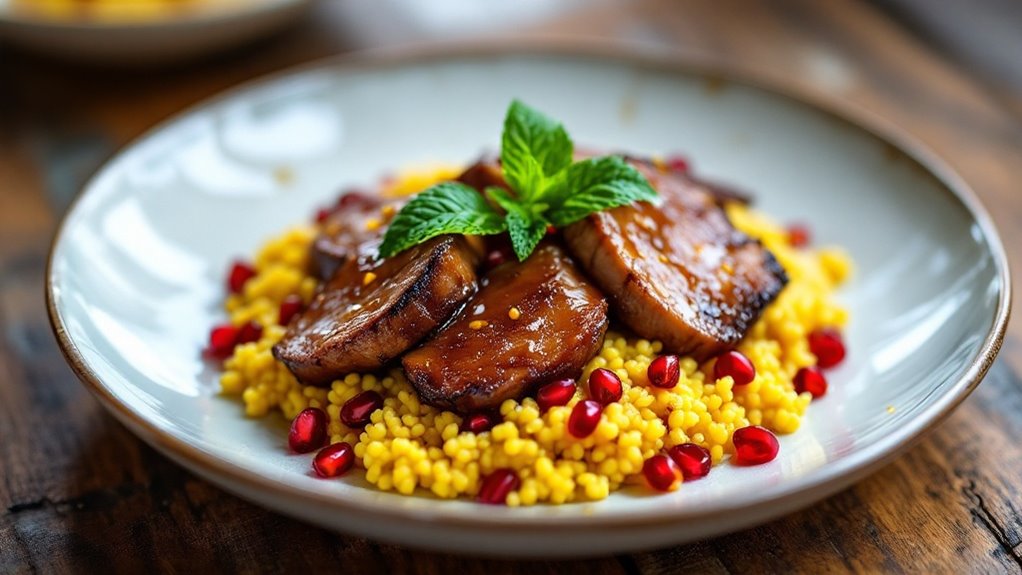Ready for a gastronomic escapade? Let’s commence with alligator meat, a Southern U.S. delight, heartily nutritious and audaciously flavor-packed, often enjoyed in jambalayas. Next, tread lightly with crocodile, remarked for its mild, versatile flavor—ideal for grilling or spring-roll crafting.
Across the ocean, kangaroo hops onto plates with its tender, lean steaks, popular among fitness buffs in Australia. For the genuinely adventurous, python offers an unconventional yet protein-rich alternative, tackling invasive species while tantalizing taste buds.
Finally, camel stands as the unsung hero of exotic meats in the Middle East, offering a healthful, slow-cooked sweetness. Uncover each one’s tantalizing secrets…
Key Takeaways
- Alligator meat, a Southern U.S. delicacy, is high in protein and omega-3, offering health benefits for adventurous eaters.
- Crocodile meat, with a mild flavor and low fat, is versatile in global cuisines and perfect for grilling or frying.
- Kangaroo meat, a lean and healthy choice from Australia, is rich in protein and CLA, ideal for various cooking methods.
- Python meat, eco-friendly and nutrient-rich, substitutes well for chicken or pork, adding uniqueness to exotic dishes.
- Camel meat, popular in the Middle East, is lean with low cholesterol, providing nutritional benefits and unique flavors.
Alligator: A Southern Delicacy
How has alligator meat become a sought-after delicacy in the southern United States? This intriguing transformation stems from a blend of culinary innovation and undeniable health benefits. Alligator dishes have made a splash in the culinary world, particularly in southern states like Florida and Louisiana, where the meat is celebrated for its versatility and unique flavor profile.
Imagine tucking into a plate of gator nuggets or savoring a bowl of spicy alligator chili—each bite offering a taste adventure. Florida alone hosts over 30 alligator farms and has an estimated 1.2 million alligators, making it a prime location for sourcing this exotic meat.
The health benefits of alligator meat further enhance its appeal. High in protein and low in fat, it’s an excellent choice for those looking to maintain a healthy diet, reducing risks of obesity and diabetes. With zero cholesterol and rich in omega-3 fatty acids, alligator meat supports heart health. Its anti-carcinogenic and anti-arthritic properties add a fascinating layer to its nutritional allure, not to mention its historical use as a remedy for ailments like colds and asthma.
Alligator dishes are not just a culinary novelty; they’re a confirmation of the blend of tradition and modern dietary awareness, making this exotic meat a star in the southern United States’ gastronomic landscape.
Crocodile: A Taste of the Wild
Exploring the domain of exotic meats, crocodile presents a distinctive culinary experience with its mild flavor and nutritional benefits. Crocodile cuisine offers a surprisingly lean option, boasting just 106 calories per 100 grams of raw tail fillet. It’s an excellent source of protein, providing 22.5 grams per serving, which impressively covers about 45% of the daily intake.
With minimal fat content, crocodile nutrition is appealing for health-conscious eaters—only 1.6 grams of fat per 100 grams, including 0.6 grams of saturated fat. Notably, the tail is the primary source of thick, white steaks, which are crucial for both the animal’s swimming ability and culinary use.
Preparing crocodile meat is an adventure in itself. Begin by thawing the fillet overnight in the refrigerator. A light rub with olive oil and your choice of steak spice or simple salt and black pepper is enough to elevate its mild flavor.
Whether grilled, pan-fried, or braaied, cooking at low to medium temperatures prevents dryness—like a cautious dance with the wild. Though marinating isn’t essential, it does promise a juicier bite. The inclusion of crocodile in global cuisines, from Japanese to Western, showcases its versatility.
Picture savoring smoked crocodile jambalaya or croc spring rolls, each dish a demonstration of this meat’s adaptability and sustainability. Remember, always source your crocodile meat from reliable providers to guarantee quality and safety.
Kangaroo: A Lean Choice

Kangaroo meat, often hailed as a sustainable choice, presents a compelling nutritional profile that appeals to health-conscious consumers. Boasting a remarkable 23.2% protein per 100g, it’s a powerhouse of complete protein, surpassing even FAO/WHO standards. With a low 2.6% fat content and merely 116.2 kcal per 100g, kangaroo meat is a lean option that doesn’t skimp on flavor or nutritional benefits.
Rich in conjugated linoleic acid (CLA), it offers anti-carcinogenic and anti-obesity properties, while high iron and zinc levels support essential body functions, making it a stellar choice for those focused on well-rounded health. Kangaroo meat is sourced from wild kangaroos in Australia and exported to 61 markets, ensuring that consumers worldwide can enjoy its unique benefits.
Now, onto cooking techniques. Given its lean texture and gamey flavor, kangaroo meat requires a delicate touch in the kitchen. To avoid dryness, marinating or slow cooking is recommended, ensuring tenderness and flavor infusion.
Cooking it medium-rare to medium helps retain its natural juiciness. Versatile in nature, kangaroo meat can grace your table as a steak, burger, or stir-fry, and pairs beautifully with robust herbs and spices.
Plus, its ethical and environmental credentials make it not just a delicious choice, but a conscientious one. So, why not hop into a culinary adventure with kangaroo?
Python: An Unusual Protein
Python meat emerges as an intriguing protein source, presenting a rich profile of lean protein, essential amino acids, vitamins, and minerals vital for human health. Rich in nutrients yet low in fat and cholesterol, python offers a healthier alternative to heavier red meats, perfect for those aiming to maintain nutritional balance.
Python sustainability comes into play as these creatures grow rapidly and require minimal resources, making them an eco-friendly choice amidst environmental challenges. Harvesting pythons could also positively impact ecosystems, particularly by controlling invasive populations in the Everglades. This is crucial because
Burmese pythons have been identified as an invasive species in Florida, threatening native wildlife. In the domain of python cuisine, this meat proves versatile. It can easily substitute chicken or pork in recipes—think python sliders or a spicy stir-fry. For the adventurous chef, pressure-cooking is key to tenderizing this meat, while making jerky involves a long marination followed by dehydration.
Python’s dense, fish-like texture offers a unique culinary experience, whether baked in a buttery sauce or skewered as satay. In Southeast Asia and Africa, python has long graced traditional tables, and it’s now making its way into Western menus, bringing a touch of exotic flair and sustainable innovation.
Camel: A Sweet Surprise

As the global palate continues to evolve, camel meat emerges as a remarkable protein choice, appreciated for its nutritional benefits and cultural significance. Picture biting into a succulent piece of camel meat, a delicacy that has nourished desert dwellers for centuries. With only about 3% fat, it’s a leaner alternative to beef and lamb, making it a treasure trove for health-conscious foodies. Not to mention, its protein content is as impressive as the protein-packed stars of the culinary world.
But wait, there’s more! Camel meat’s low cholesterol and high water content make it a heart-friendly choice, while its rich mineral and vitamin profile, including a surprising dose of potassium and a medley of vitamins like B6 and B12, guarantees it’s not only tasty but also nutritious. Health benefits abound, from alleviating hyperacidity to easing respiratory woes—a camel cure-all of sorts! Furthermore, camel meat is rich in iron, boasting significantly higher levels than beef or poultry, which makes it a great choice for those looking to boost their iron intake.
Culturally, camel meat holds a special place in the Middle East and North-East Africa, where it’s lovingly marinated and slow-cooked to perfection. So, next time you’re seeking an adventurous feast, why not give camel meat a try? It’s a sweet surprise you won’t regret!
Wrapping up
Exploring exotic meats, such as alligator, crocodile, kangaroo, python, and camel, invites culinary curiosity and cultural connection. These daring dishes deliver diverse delights, each offering a unique taste and texture that tantalizes taste buds and tickles the adventurous spirit. Historically heralded in various regions, these proteins provide nutritional benefits and sustain sustainable practices.
Savoring such selections not only enriches one’s palate but also promotes a profound appreciation for global gastronomy, encouraging an acceptance of the unfamiliar with open-minded enthusiasm.




